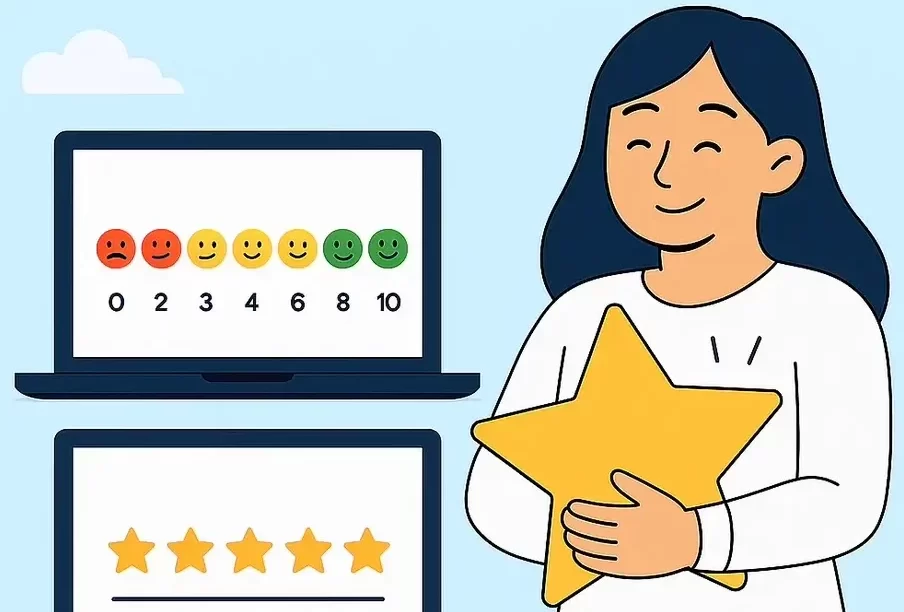Customer feedback metrics can make or break your customer experience strategy. But with so many options available, how do you know which ones actually move the needle?
Two metrics consistently rise to the top: Net Promoter Score (NPS) and Customer Satisfaction (CSAT).
Both offer valuable insights, but they serve very different purposes in your feedback arsenal.
For a comprehensive comparison of CES, CSAT, and NPS metrics, understanding these differences is crucial for building an effective measurement strategy.
What Are NPS and CSAT Metrics?
What is Customer Satisfaction (CSAT)
CSAT measures how satisfied customers are with specific interactions, products, or services. It’s the most straightforward feedback metric you can deploy.
Customers rate their satisfaction on a scale (typically 1-5), giving you immediate insight into how well you’re meeting expectations at specific touchpoints.
This transactional nature makes CSAT perfect for capturing in-the-moment reactions.
For a detailed CSAT definition and methodology, you’ll find that its simplicity is also its strength.
What is Net Promoter Score (NPS)
NPS focuses on customer loyalty and advocacy rather than individual interactions. The core question asks customers how likely they are to recommend your company on a 0-10 scale.
Based on responses, customers fall into three categories:
- Promoters (9-10): Your biggest fans who actively recommend you
- Passives (7-8): Satisfied but not enthusiastic customers
- Detractors (0-6): Unhappy customers who might warn others away
Key Differences Between NPS and CSAT
Scope and Focus
The fundamental difference comes down to scope. CSAT zooms in on specific moments, while NPS zooms out to see the bigger picture.
CSAT answers: “How did we do with this particular interaction?” NPS answers: “How do you feel about us overall?” This distinction shapes everything about how you use these metrics.
Timing and Frequency
CSAT works best when deployed immediately after customer interactions. Strike while the iron is hot—capture feedback when the experience is fresh.
NPS surveys should be sent less frequently, typically quarterly. You’re measuring overall sentiment, which doesn’t change dramatically from week to week. However, transactional NPS methodology offers a middle ground by measuring advocacy at specific touchpoints.
Actionability of Insights
CSAT provides tactical insights you can act on quickly. If customers rate your checkout process poorly, you know exactly what to fix.
NPS offers strategic insights that inform longer-term planning. A declining NPS score signals relationship issues that might require broader organizational changes.
How to Calculate NPS and CSAT Scores
CSAT Calculation Method
Count satisfied customers (those rating 4-5 on a 5-point scale), divide by total responses, and multiply by 100. If 75 out of 100 customers rate their experience as 4 or 5, your CSAT score is 75%.
Most industries consider anything above 80% a good CSAT score. But benchmarks vary significantly by sector—luxury services typically see higher scores than utilities or telecom companies.
NPS Calculation Method
First, categorize responses into Promoters (9-10), Passives (7-8), and Detractors (0-6). Then subtract the percentage of Detractors from the percentage of Promoters.
The result is a score between -100 and +100. Anything above 0 is positive, above 50 is excellent, and above 70 is world-class.
When to Use CSAT vs NPS
Best Use Cases for CSAT
CSAT shines when you need immediate, actionable feedback about specific touchpoints. Understanding CSAT features and practical usage scenarios helps you deploy this metric effectively:
- Post-support interactions: How satisfied were customers with their service call?
- Product feedback: Are customers happy with their recent purchase?
- Process evaluation: Did the onboarding experience meet expectations?
- Service delivery: How well did we handle that installation or delivery?
Best Use Cases for NPS
NPS excels at measuring broader relationship health and predicting future behavior:
- Brand loyalty tracking: How strong is our customer base’s emotional connection?
- Churn prediction: Which customers might be at risk of leaving?
- Growth potential: Who are our most valuable advocates?
- Strategic planning: How are our major initiatives affecting customer sentiment?
Using Both Metrics Together
The real magic happens when you combine both metrics strategically. CSAT identifies what to fix, while NPS reveals whether those fixes are building stronger relationships.
You might discover that customers are satisfied with individual interactions (high CSAT) but still wouldn’t recommend you (low NPS). This gap signals deeper issues with value proposition or competitive positioning. Consider adding Customer Effort Score (CES) as a complementary metric to complete your measurement framework.
Industry Benchmarks and Performance Standards
CSAT Benchmarks by Industry
CSAT expectations vary dramatically across industries:
High-performing industries:
- Healthcare services: 85%+
- Luxury retail: 85%+
- Professional services: 80-85%
Moderate-performing industries:
- Technology/SaaS: 75-85%
- Financial services: 75-80%
- E-commerce: 70-80%
Challenging industries:
- Telecommunications: 60-70%
- Utilities: 60-70%
- Government services: 55-65%
NPS Benchmarks by Industry
World-class performers:
- Technology leaders: 60-70+
- Luxury brands: 50-70+
- Subscription services: 40-60+
Solid performers:
- Financial services: 20-40
- Healthcare: 20-40
- Retail: 15-35
Challenging sectors:
- Airlines: -10 to +20
- Telecommunications: -15 to +15
- Utilities: -20 to +10
How SurveyVista Simplifies NPS and CSAT Collection
Native Salesforce Integration Benefits
SurveyVista eliminates the headache of managing multiple platforms. Your feedback data flows directly into Salesforce where it belongs, without any integration nightmares.
No more data silos or sync delays. Your team doesn’t need to learn new tools or juggle multiple dashboards.
Streamlined Survey Management
Deploy both NPS and CSAT surveys without writing a single line of code.
SurveyVista’s template library gets you started quickly with proven question formats.
Automated triggers ensure surveys reach customers at exactly the right moments. Mobile-optimized surveys deliver consistently high response rates.
Actionable Insights and Reporting
Real-time dashboards show both metrics side by side, revealing patterns that individual scores might miss.
Automated alerts notify the right team members when scores drop below acceptable thresholds.
Customer journey mapping connects feedback to specific touchpoints, helping you understand which experiences drive satisfaction and loyalty.
Choosing the Right Metric for Your Business
Getting Started with Customer Feedback
Begin with a pilot program focusing on your most critical customer touchpoints. Choose one metric to start if resources are limited—CSAT provides quicker wins, while NPS offers more strategic insights.
Set realistic timelines for seeing results. CSAT improvements can happen quickly, but NPS changes take longer to materialize.
Customer feedback metrics aren’t just numbers—they’re your roadmap to better customer relationships. CSAT and NPS each offer unique insights that, when used together, create a powerful foundation for customer-centric growth.
The key is understanding what each metric tells you and acting on those insights consistently. Whether you’re fixing immediate pain points with CSAT or building long-term loyalty through NPS tracking, success comes from closing the loop between feedback and action.
Ready to transform your customer feedback program? SurveyVista’s native Salesforce integration makes it easy to collect, integrate, and act on both NPS and CSAT data without the complexity of managing multiple platforms.
Frequently Asked Questions
Can I use both NPS and CSAT surveys for the same customers?
Yes, but space them strategically. Deploy CSAT immediately after specific interactions and NPS quarterly. This prevents survey fatigue while capturing both tactical feedback and relationship health insights.
Which metric is better for predicting customer churn?
NPS is generally better for churn prediction since it measures overall relationship health. However, consistently low CSAT scores across multiple touchpoints can also signal churn risk.
Do I need separate surveys for NPS and CSAT, or can I combine them?
Keep them separate for best results. CSAT works best immediately after interactions, while NPS should be sent less frequently. Combining them can confuse respondents and reduce response quality.
More Like This

Rajesh Unadkat 
Founder and CEO
Rajesh is the visionary leader at the helm of SurveyVista. With a profound vision for the transformative potential of survey solutions, he founded the company in 2020. Rajesh's unwavering commitment to harnessing the power of data-driven insights has led to SurveyVista's rapid evolution as an industry leader.
Connect with Rajesh on LinkedIn to stay updated on the latest insights into the world of survey solutions for customer and employee experience management.



